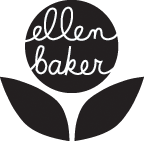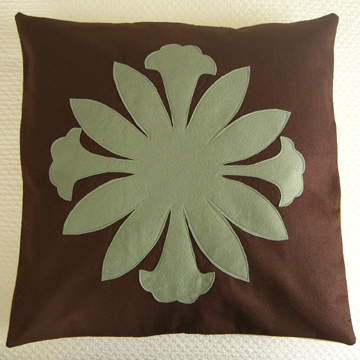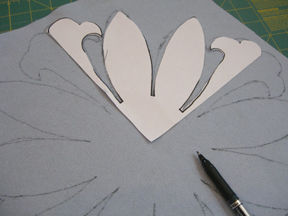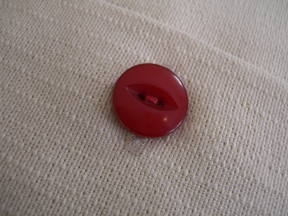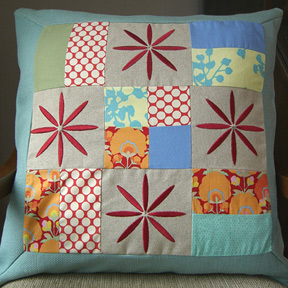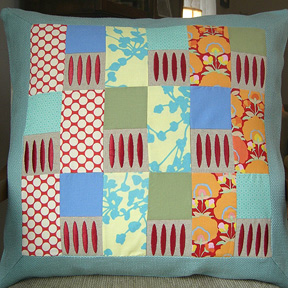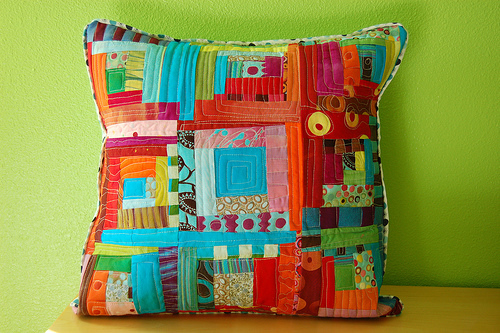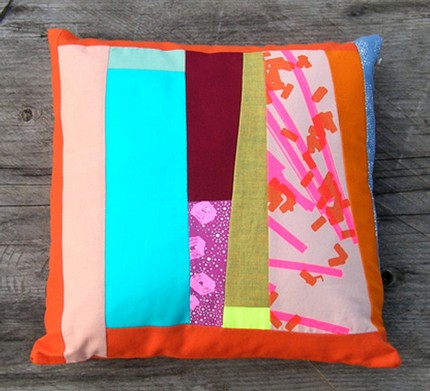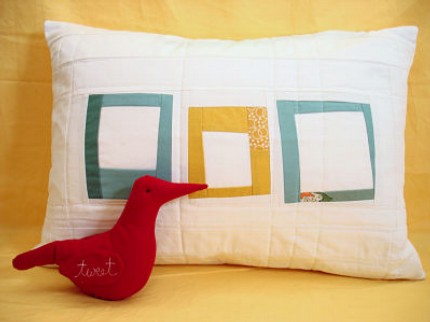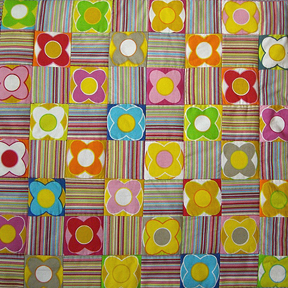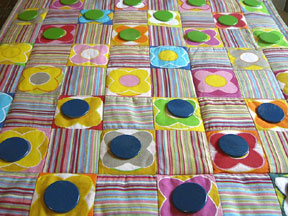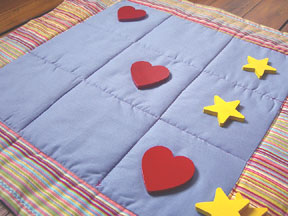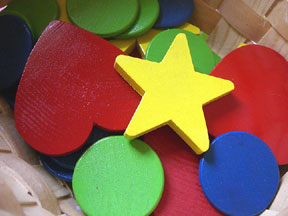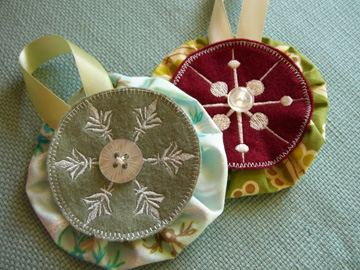I’ve been sorting through my fabric over the past few days and came across the box of old baby dresses and such that were mine. These were either stained or too worn for the girls to wear, so I’ve been planning to make them into a quilt. I thought I’d post some photos of what I found because I love them so. I’m hesitant to cut these up until I have some kind of fabulous plan for this quilt. I thought I did, but I changed my mind. Suggestions welcomed.
Folk Art Felt Pillow
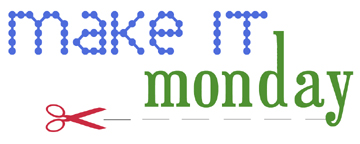
Inspired by Hawaiian quilts and folk art traditions, I created a flower pattern that can be appliquéd for a 20″x20″ pillow. I’m giving complete instructions for making the pillow, so if you’re not interested in trying the appliqué you can still use the tutorial to learn to make a pillow cover. I used a wool blend for the front of this pillow and a canvas fabric for the back. The felt is easy to work with and cut, but I would recommend using 100% wool or a high-quality blend for durability. I think this would be great in a variety of colors.
Rather than attaching a .pdf file, I will just give the instructions here, as they are pretty quick. This project may take an hour or two. This is difficult for me to estimate because I was working on it with kids “helping”. I think a beginner can do this, but you might want to practice sewing around corners and edges.
Supplies:
- felt: 1 yard of background color, 1/2 yard of contrasting felt
- backing fabric: 1 yard of canvas, felt, or upholstery fabric
- small, sharp scissors
- fabric marker or regular pen
- pins
- 2 large buttons
- thread to match contrasting felt color
- 20″ x 20″pillow form
Step 1: Cut Fabric
- Background felt: 22″x22″
- Pillow Back (2 pieces): 22″x17″, 22″x14″
Step 2: Create Appliqué Shape
- Print and cut out template below. Card stock might be helpful here.
- Trace pattern directly onto felt with a fabric marker or regular pen, then rotate design 90 degrees and continue until you have the full flower effect (if using a regular pen, be sure to flip over before sewing design to hide markings).
- Carefully cut out shape with small, sharp scissors.
- Fold pillow front background fabric in halves to mark center (or measure), then pin appliqué design to the center of the fabric, with at least one pin in each point of the flower. Felt sticks to itself pretty well, so you shouldn’t have too much trouble with slipping as you sew.
- With matching thread, carefully sew shape onto pillow background with a straight stitch, moving slowly around the corners. Stitching should be almost to the edge. Take your time.
Step 4: Buttonholes
- Take the two pieces of backing fabric and fold one edge of each piece down 3″ (on a 22″ side). If you can manage it, try to have the selvege ends folding down; otherwise, run a quick overcasting stitch along the edge to prevent fraying. Press the folds down.
- On the larger piece, measure 7 1/2″ in from each edge and 1/2″ up from fold. Mark this as the bottom of your buttonhole. Sew buttonholes perpendicular to the fold in the fabric, as shown in photo below (this helps keep them from opening).
Step 5: Sew Pillow Together
Make a “fabric sandwich” in the following order:
- felt pillow front piece (with appliqué side face up).
- backing fabric larger piece with buttonhole (wrong side facing up).
- backing fabric without buttonhole next (wrong side facing up). The fabric with the buttonholes should overlap the smaller piece by about 3″ to form pillow opening.
- Pin and sew fabric together.
- Trim excess and corners.
- Cut buttonholes open with a seam ripper or sharp scissors (you can put a pin in the bottom so you don’t cut too far).
- Turn right side out and sew buttons. It helps to lay pillow cover flat and draw a line through the buttonhole to mark the correct spot for the button.
All done! Hope this makes sense. Please let me know if you have any questions or suggestions.
Patchwork and Quilted Pillows
I made these pillows last week in my patchwork frenzy and just finished them last night. I embroidered the flowers and lines and sewed them in with the cotton prints. I used upholstery fabric for the border and backing so I’ll need to have them dry cleaned after the inevitable jelly hands get to them.
After I made these, I found this totally amazing pillow from A Stitch in Dye which is giving my pillows an inferiority complex. You can see her beautiful work on her Flickr page here and more for sale in her Etsy shop. She also has a blog here. Wow, I’m a fan! I am really in love with the hand dyed look, inspired color choices and beautiful free form quilting. These must have taken hours to make and they are really inexpensive ($40 and $42 each).
Here are a couple of other nice quilted pillows:
This one is from Raeburn Ink, $70.
And this one by Neressa Bennett, $95.
All of these modern quilt designs make me think of the Quilts of Gee’s Bend. I felt inspired when I saw this exhibition and I urge you to take a look at the patterns, color and design for inspiration even if you are not a quilter.
Checkerboard Quilt
Since I updated our playroom, I wanted to make something that the girls could use so I decided to make a checkerboard quilt using this flower fabric from IKEA and some striped fabric that I had on hand. I quickly realized that a checkerboard has 64 squares! I cut 3″ squares and made the top. I then decided to make things more difficult by making the reverse side a tic-tac-toe game board. This was a little tricky, so I decided to just use one piece of fabric and delineate the squares with the stitching. There is a lot of math in quilting. Argh.
But I am enjoying my first attempts at quilting. I love to come up with a design and piece it together. I’m having a little trouble putting it together and finishing the edges. You can see on this project I finished with the fabric from the reverse side. I can see why this is not the recommended quilting method because you would be much less likely to get puckering with a separate piece of fabric. But I was too lazy to cut binding.
We went to the craft store and bought some unpainted wooden chips for the checkerboard pieces, which we painted green and blue. We couldn’t find Xs and Os, so we went with hearts and stars instead and painted those as well. I think it would be nice to make a pouch for the game pieces and ties to roll up the board and take it with you.
Yo-Yo Ornaments
What? The holidays are over? We have a dead Christmas tree and I just now completed my ornaments for the Holiday Ornament Swap.
Now granted; I never did receive my list of swapmates, but finally got the list from someone who graciously sent me an ornament. Thank you! So here are my ornaments all made and ready to ship. Better late than never? The first photo shows all nine ornaments stacked up and makes me wish I’d made little yo-yo accordion ornaments, but the next photo is what the ornaments look like on their own. This is the first time I have made fabric yo-yos and I love them! Here are some very nice instructions. So many possibilities and you can make them while watching Project Runway.
